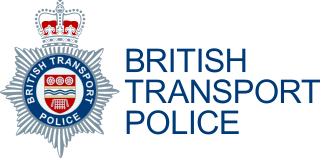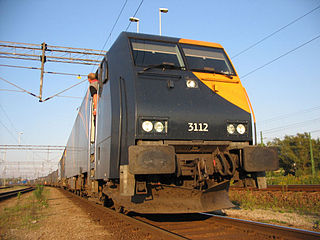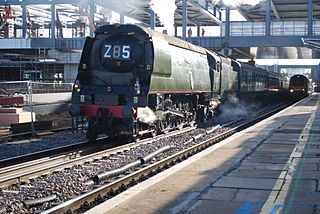
British Transport Police is a national special police force that polices the railway network of England, Wales and Scotland. The force polices more than 10,000 miles of track and more than 3,000 stations and depots.
The Ladbroke Grove rail crash was a rail accident which occurred on 5 October 1999 at Ladbroke Grove in London, England, when two passenger trains collided almost head-on after one of them had passed a signal at danger. With 31 people killed and 417 injured, it was one of the worst rail accidents in 20th-century British history.

West Coast Railways (WCR) is a railway spot-hire company and charter train operator based at Carnforth MPD in Lancashire. Using buildings and other facilities previously owned by the Steamtown Carnforth visitor attraction, in June 1998 the company became the first privately owned company to be given a licence as a train operating company.

A signal passed at danger (SPAD), known in the United States as a stop signal overrun (SSO) and in Canada as passing a stop signal, is an event on a railway where a train passes a stop signal without authority. This is also known as running a red.

Safety culture is the collection of the beliefs, perceptions and values that employees share in relation to risks within an organization, such as a workplace or community. Safety culture is a part of organizational culture, and has been described in a variety of ways; notably the National Academies of Science and the Association of Land Grant and Public Universities have published summaries on this topic in 2014 and 2016.
A near miss, near death, near hit or close call is an unplanned event that has the potential to cause, but does not actually result in human injury, environmental or equipment damage, or an interruption to normal operation.

The Rail Accident Investigation Branch (RAIB) is a British government agency that independently investigates rail accidents in the United Kingdom and the Channel Tunnel in order to find a cause, not to lay blame. Created in 2005, it is required by law to investigate accidents causing death, serious injuries or extensive damage. It also has authority to investigate incidents that could have resulted in accidents.

The Rail Safety and Standards Board (RSSB) is a British independent company limited by guarantee. Interested parties include various rail industry organisations, including Network Rail, train operating companies (TOCs), and rolling stock companies (ROSCOs). The RSSB operates as a not-for-profit entity, its primary purpose being to bring about improved health and safety performance throughout Britain's railway network.

One-person operation (OPO), also known as driver-only operation (DOO), one-man operation (OMO), single person train operation (SPTO), or one-person train operation (OPTO), similarly to Driver Controlled Operation, is operation of a train, bus, or tram by the driver alone, without a conductor.

Automatic block signaling (ABS), spelled automatic block signalling or called track circuit block (TCB) in the UK, is a railroad communications system that consists of a series of signals that divide a railway line into a series of sections, called blocks. The system controls the movement of trains between the blocks using automatic signals. ABS operation is designed to allow trains operating in the same direction to follow each other in a safe manner without risk of rear-end collision.

A rail replacement bus service uses buses to replace a passenger train service on a temporary or permanent basis. The train service that is replaced may be of any type such as light rail, tram, streetcar, commuter rail, regional rail or heavy rail, intercity passenger service. The rail service may be replaced if the line is closed because of rail maintenance, a breakdown of a train, a rail accident or a strike action or to simply provide additional capacity or if the rail service is not economically viable.

The Rail Safety Act 2006 is a law enacted by the Parliament of the State of Victoria, Australia, and is the prime statute regulating the safety of rail operations in Victoria. The Act was developed as part of the Transport Legislation Review conducted by the Department of Transport between 2004 and 2010 and is aimed at preventing deaths and injuries arising from rail operations.
The Chief Investigator, Transport Safety is the independent Government agency responsible for investigation of safety-related trends and incidents in the rail, bus and marine industries in the State of Victoria, Australia.

The Bus Safety Act 2009 is a law enacted by the Parliament of the State of Victoria, Australia and is the prime statute regulating the safety of bus operations in Victoria. The Act was developed as part of the Transport Legislation Review conducted by the Department of Transport between 2004 and 2010 and is aimed at preventing deaths and injuries arising from bus operations in Victoria and establishes a modern "best practice" regulatory framework to assist in maintaining and improving the Victorian bus industry's good safety record.
A safety taxonomy is a standardized set of terminologies used within the fields of safety and health care. The goal is to foster clear communication, as the terminology used within these fields can be immensely confusing, even to specialists.
Heritage Operations Processing System, Heritage Ops, short named HOPS, is a web-based tool for the day-to-day running and management of preserved and heritage railways. The system was developed, from a concept drawn up by Danny Scroggins and Luke Cartey.
A confidential incident reporting system is a mechanism which allows problems in safety-critical fields such as aviation and medicine to be reported in confidence. This allows events to be reported which otherwise might not be reported through fear of blame or reprisals against the reporter. Analysis of the reported incidents can provide insight into how those events occurred, which can spur the development of measures to make the system safer.

On 7 March 2015, a steam-hauled charter train passed a signal at danger and subsequently came to a stand across a high-speed mainline junction near Wootton Bassett Junction, Wiltshire, England. Another train, which had right of way, had passed through the junction 44 seconds earlier and no collision occurred nor was any damage done.

The impact of the privatisation of British Rail has been the subject of much debate, with the stated benefits including improved customer service, and more investment; and stated drawbacks including higher fares, lower punctuality and increased rail subsidies. The privatisation of British Rail began in the 1990s.
Automatic Train Protection (ATP) is a method of beacon based railway cab signalling developed by British Rail. The system is only installed on the Great Western Main Line between London Paddington and Bristol Temple Meads, and the Chiltern Main Line from London Marylebone to High Wycombe and Aylesbury.













